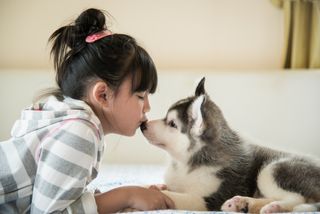My Windows Arent Dirty Thats Just My Dogs Nose Art
Why practise dogs have cold noses?

After an peculiarly good belly rub, a dog might bump its olfactory organ into its human every bit a way of saying thanks. Oftentimes, this snoot boop feels common cold and wet. The owner might wonder: Is information technology normal for a dog'southward olfactory organ to feel similar this?
The respond is yes, information technology'southward normal. Merely and so is a warm nose, especially afterward snoozing, said Anna Bálint, a researcher who studies brute behavior at Eötvös Loránd Academy in Budapest, Hungary. "When a domestic dog is asleep, their nose usually warms upwardly, and it also dries," she told Live Science. Then, the dog wakes upward, gives its nose a lick, and it's back to common cold.
But why are dogs' noses common cold, and could there exist a benefit?
Related: Are dogs really smile at united states?
One idea is that the dog's common cold nose could help the hirsuite beast regulate its torso temperature. But the nose tip is and then small, it'due south probable unable to meaningfully contribute to a dog'southward overall thermal regulation, Bálint said.
To investigate further, an international team of scientists measured the temperature of many animals' noses, including a horse, canis familiaris and moose. Past the time Bálint joined the project, the team had already learned that the nose tips, or rhinariums, of dogs and cannibal animals are normally cooler than those of herbivores. Perhaps, a cooler olfactory organ tip could be an reward in the wild, the researchers thought.
The squad conducted ii experiments — one looking at behavior and another at the brain — to run into whether a cold rhinarium could make for improve rut detection. In the kickoff experiment, the team successfully trained iii pet dogs to cull a warmer object, about the aforementioned temperature as potential prey, over an object at room temperature. The results indicated that dogs tin find weak thermal radiations from a altitude alike to hunting casualty.
In the second, brain-axial investigation, scientists presented a box containing warm water and an insulating door to 13 pet dogs trained to lie notwithstanding in a functional MRI scanner. The dogs' brains had a college response when the insulating door was open up, revealing the warmer surface, equally compared with the neutral one. The region that lit up on the MRI was located in the left hemisphere simply. This side of the brain interests scientists because it tends to process responses to nutrient, which in turn has been linked to predatory activity in many vertebrates, Bálint said. The specific region that lit upward in the dogs — known as the somatosensory clan cortex — helps join different sensations such as vision, body position and warmth, she added. This part of the brain combines these senses simultaneously in order to plan an action toward a goal, like targeting an object.
Given that this left-sided neural region lit up when the nose tip was exposed to a warm surface, it's possible that dogs, and possibly other common cold-nosed animals, could exist using a heat detection sense forth with other senses in their 'hunting toolbox' when they're in pursuit of casualty, the researchers said.
Although the recent report, published in February 2020 in the journal Scientific Reports, is likewise small to firmly close the case on cold noses, Bálint said a common cold nose could be more sensitive to differences in temperature. "People call back canines follow their olfaction [sense of smell], which is probably actually true," Bálint said. But windy conditions or stormy weather can arrive hard for a working domestic dog to follow scents. "A estrus signal could help them."
So, why is a canis familiaris's nose common cold? Bálint and her team proceed to search for answers to this question. Now, they're wondering at what distance this type of heat detection could be useful. For at present, but the dog's olfactory organ knows.
Originally published on Live Science.
Source: https://www.livescience.com/why-dogs-noses-are-cold-wet.html
0 Response to "My Windows Arent Dirty Thats Just My Dogs Nose Art"
Postar um comentário